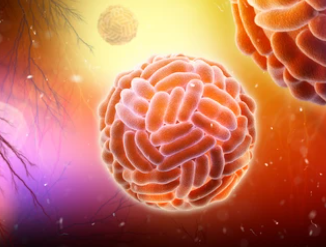Proteomics in ZIKV Research
Zika virus (ZIKV) belonging to the Flaviviridae family, Flavivirusgenus, has recently been the focus of immense investigation due to its correlation to neurological syndromes and congenital developmental deficits. Here, we give an overview of the proteomic study of ZIKV, hoping to promote the study of ZIKV-host protein interactions, ZIKV pathogenesis, and the development of new drug targets. A systematic understanding of virus-host protein-protein interactions (PPIs) mapping greatly promotes the discovery of host cellular pathways critical to ZIKV tropism and pathogenesis. Based on the proteomic analysis of interactions between individual ZIKV viral proteins and host proteins, multiple conserved cellular pathways and protein complexes (such as proteasome complexes) are identified.
Zika virus (ZIKV)
 Zika virus (ZIKV) is a neurotropic virus transmitted mainly by the Aedes aegypti mosquito. It has emerged as a global health problem since its arrival in the Western Hemisphere in 2013. ZIKV can lead to varying degrees of disease in adults (ranging from a mild, febrile illness to severe neurological disorders) and cause congenital malformations and microcephaly in newborns.
Zika virus (ZIKV) is a neurotropic virus transmitted mainly by the Aedes aegypti mosquito. It has emerged as a global health problem since its arrival in the Western Hemisphere in 2013. ZIKV can lead to varying degrees of disease in adults (ranging from a mild, febrile illness to severe neurological disorders) and cause congenital malformations and microcephaly in newborns.
ZIKV is composed of a single positive-strand RNA, which is translated into a polyprotein and then cleaved into components necessary for viral replication and assembly, including three structure proteins (C, prM/M, and E) and seven non-structure proteins (NS1, NS2A, NS2B, NS3, NS4A, NS4B, and NS5). Like other flaviviruses, each viral protein is able to affect cellular events. By virtue of their structural glycoproteins, Flavivirusare able to attach to the host cell, then interact with several receptors, triggering endocytosis pathways. ZIKV uses their envelope (E) glycoprotein to enter multiple cell types, including fibroblasts, immature dendritic cells, and epidermal keratinocytes. There is a difference in glycosylation within the ZIKV strains compared with other members of the Flaviviridae family, which determines the affinity for human target proteins.
Proteomic technologies used in HIV studies
Over the past few years, many studies have applied multiple proteomic approaches to investigate the virus-host protein interactions and alterations in the host proteome upon ZIKV infection. Several cellular host proteins, organelles, or pathways implicated in ZIKV infection have been identified using novel technologies in the field of proteomics.
ZIKV-host interactions
Systematic studies of identifying virus-host protein-protein interactions (PPIs) are necessary for an unbiased view of molecular complexes and insights into viral replication and pathogenesis, which can be achieved by using affinity purification (AP) followed by MS analysis (AP-MS) in a systematic and comparative fashion. Based on the novel technologies in the field of proteomics, there are several key advances in ZIKV-host protein-protein interactions, including interactions of ZIKV capsid with host proteins and interactions of ZIKV NS4B (a non-structural and conserved protein of ZIKV) with the host. Besides capsid and NS4B, novel ZIKV NS5 binders have been identified in the recent proteomic surveys.
Global proteome expression affected by ZIKV infection
There are also several studies that explore the impact of ZIKV infections on protein abundance on a global scale. By using label-free shotgun proteomics combined with transcriptomic analysis, researchers had studied the impact of ZIKV strain isolated in Brazil on human neurospheres and revealed a series of downregulated and upregulated proteins. A similar unbiased study had investigated the proteome of ZIKV-infected iPSC-derived human neuronal progenitors, confirming specific downregulation of neuronal factors and activation of general antiviral response pathways upon ZIKV infection. In addition, multidimensional protein identification technology (MudPIT) has recently been applied to investigate the impact of ZIKV infection on human mesenchymal stem cells.
Post-translational modifications (PTMs) modulated by ZIKV
So far, there are few studies reported on post-translational modification (PTM) analysis of ZIKV infections. A report revealed a time-resolved phosphoproteomic analysis of ZIKV-infected cells and identified and analyzed many proteins modulated upon ZIKV infection. With the development of techniques and bioinformatic tools, a better interpretation of PTM activities is not far off, holding promise dramatically promotes our understanding of ZIKV-host interactions and identification of additional important pathways engaged during viral infections.
Creative Proteomics is a leading service provider in the field of viral proteomics. We continuously challenge ourselves and strive to offer our global customers the finest service. Based on professional scientists and advanced platforms, we are capable of providing a series of proteomic techniques to help customers quickly and comprehensively investigate viral proteomics, including viral protein structure detection, global proteome profiling, mass spectrometry-based viral proteomics, and so on. For more information on how we can help you, please feel free to contact us or directly send us an inquiry.
Reference
- Scaturro, P., et al. (2019). "Chasing intracellular Zika virus using proteomics." Viruses, 11(9), 878.
Related services
* For research use only.

 Zika virus (ZIKV) is a neurotropic virus transmitted mainly by the Aedes aegypti mosquito. It has emerged as a global health problem since its arrival in the Western Hemisphere in 2013. ZIKV can lead to varying degrees of disease in adults (ranging from a mild, febrile illness to severe neurological disorders) and cause congenital malformations and microcephaly in newborns.
Zika virus (ZIKV) is a neurotropic virus transmitted mainly by the Aedes aegypti mosquito. It has emerged as a global health problem since its arrival in the Western Hemisphere in 2013. ZIKV can lead to varying degrees of disease in adults (ranging from a mild, febrile illness to severe neurological disorders) and cause congenital malformations and microcephaly in newborns.